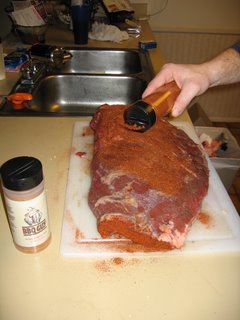Today's project is brisket.

I purchased a 14 lb. Certified Angus Brisket at my local butcher shop. I had to order it because this type of specialty meat is not something they normally keep on hand, but it's one a handful of places that I've found that sells "whole" untrimmed briskets.

This is a picture of the fat cap on the CAB brisket I'll be cooking. At this point I haven't trimmed any of the excess.

I begin to trim the fat. I remove much of the "hard" fat from the brisket. The knife tip is pointing toward a 1 1/2 - 2 inch portion of segment that runs between the "point" and the "flat".

I use a special tenderizing tool called a Jaccard to pierce the meat before seasoning with my "secret" spice rub mixture. Piercing the meat allows the seasoning to penetrate deeper into the meat and also helps shorten the cooking time a little.

I start at one end and liberally apply The BBQ Guy Original Beef Rub to the both sides of the brisket. You can't use too much of this stuff. It's gooooooood.

The rub is applied and the brisket is ready to marinade in the refrigerator overnight before cooking. I prefer to let the brisket set for 8-10 hours before cooking.

Here's a picture of the brisket after I removed it form the refrigerator the next morning just before placing it on the smoker for cooking.

Here's a picture of the brisket cooking in the Weber Smokey Mountain (WSM). I've got a dual probe digital thermometer that I use to monitor the internal meat temperature on whole briskets. Brisket thickness varies quite a bit and like to monitor the flat in two places to ensure I don't over cook the meat.

Here's a picture of the final results.
2 comments:
I like to use less rub and leave the fat cap on. I also try not to do anything to "shorten" the cooking time.
I should clarify that I don't remove all the fat cap. I leave about a 1/4 inch. I've found that leaving all the fat reduces the amount of bark formation.
When I started doing it this way we went from finishing out of the top 10 in brisket to winning the category in bbq contests.
Post a Comment